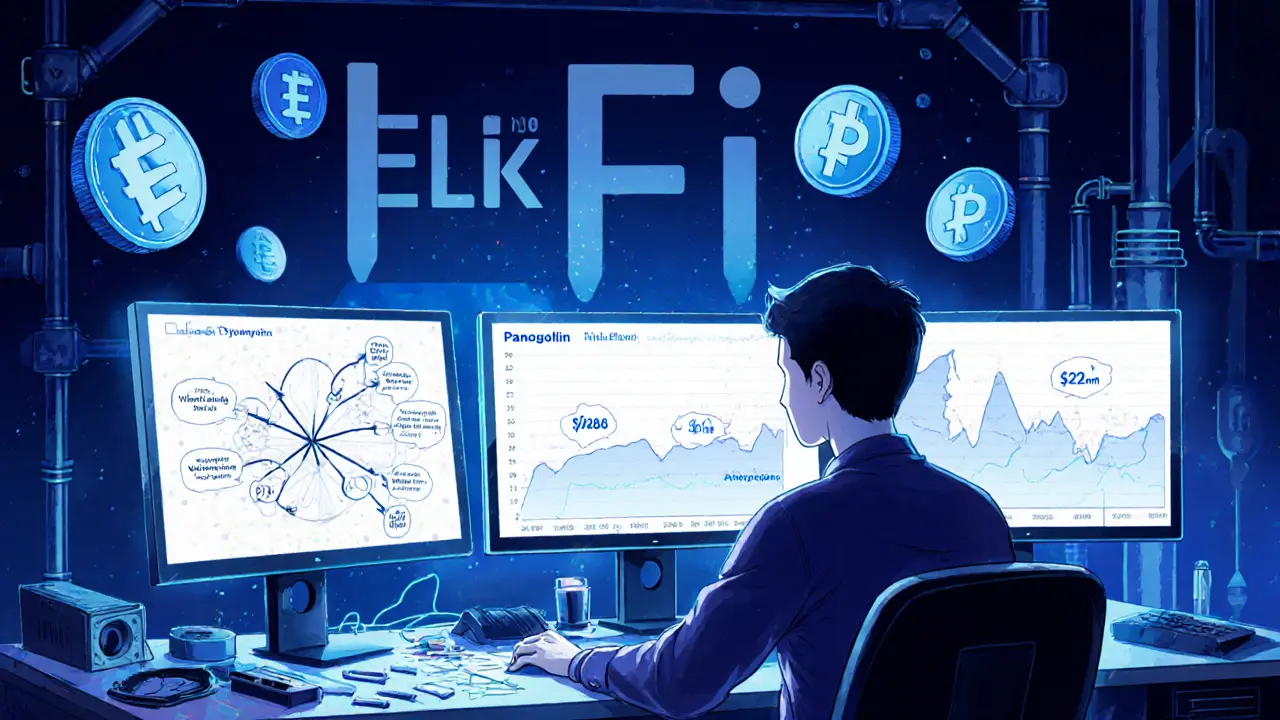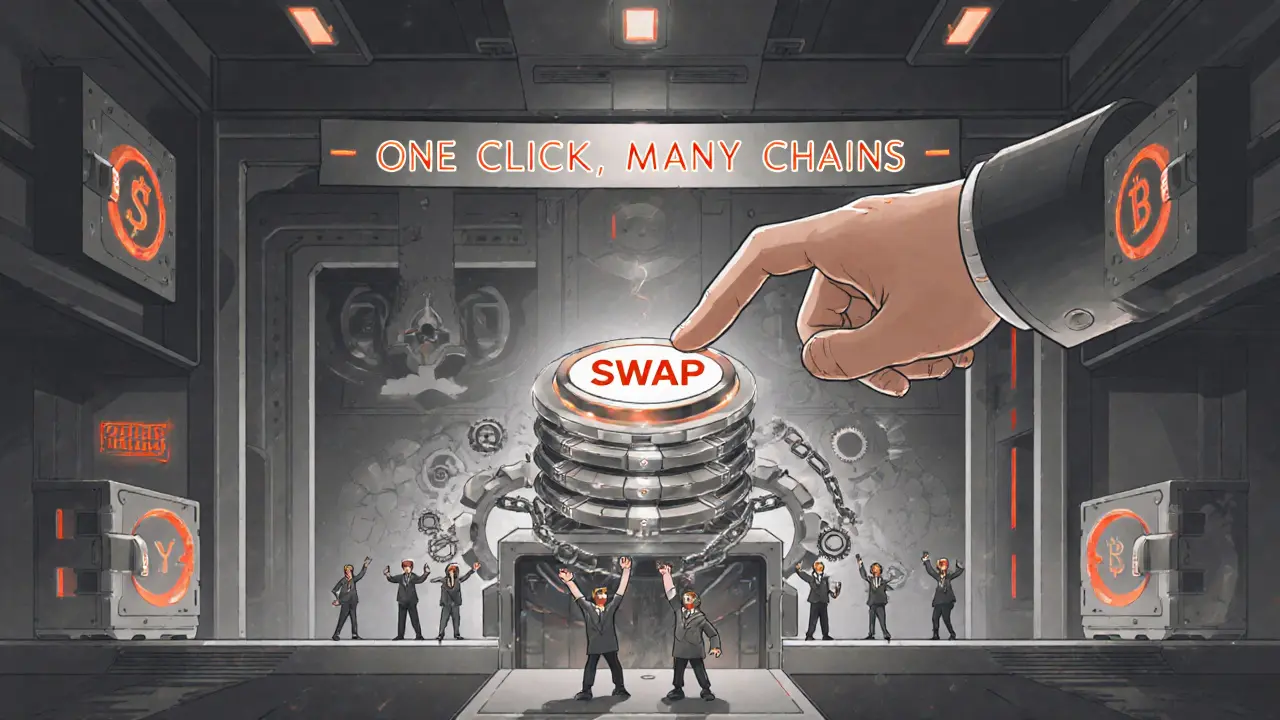Elk Finance (Avalanche) Crypto Exchange Review: Cross-Chain Swaps Done Right?
 Nov, 1 2025
Nov, 1 2025
Cross-Chain Swap Calculator
Estimate your cross-chain swap using Elk Finance. Note: Avalanche liquidity is extremely limited (only 4 tokens available). Results may vary due to low volume and high slippage.
Estimated Swap Result
Warning: Due to extremely low liquidity on Avalanche, this estimate may have high slippage. The actual swap may be significantly different.
Most crypto users know the pain: you want to swap ETH for SOL, but instead of one click, you’re stuck bridging, waiting for confirmations, then hopping to another DEX. It’s messy. Elk Finance promises to fix that - all in one transaction, across 15+ blockchains. But does it actually work in practice, especially on Avalanche?
What Is Elk Finance?
Elk Finance is a decentralized exchange built to move crypto between chains without manual bridges. Launched in 2021, it’s not another Uniswap clone. It’s a routing engine that splits your swap into multiple hops across different networks - Ethereum, BSC, Solana, Polygon, and Avalanche - to find the cheapest path. Think of it like a GPS for crypto: instead of driving straight (which might be blocked or expensive), it finds the fastest detour through side roads.
It runs on smart contracts deployed on each supported chain. On Avalanche, you’ll find just four coins and six trading pairs. The most active? ELK/WAVAX. That’s it. No BTC, no ETH, no USDC. Just ELK and its native token. That’s a red flag for anyone expecting a full DEX experience.
How Elk Finance Works on Avalanche
Here’s the real trick: Elk Finance doesn’t hold your assets. It uses liquidity vaults on each chain. When you swap from Ethereum to Solana, it pulls ETH from an Ethereum vault, sends it to a bridge, then releases SOL from a Solana vault - all in one click. No need to go to a bridge site, approve two transactions, wait 10 minutes, then go to another DEX.
On Avalanche, the process is the same. Connect your MetaMask or WalletConnect, pick your tokens, and hit swap. The platform finds the cheapest route - sometimes using WAVAX as a bridge token. It’s slick in theory. But here’s the catch: liquidity on Avalanche is tiny. As of October 2025, the 24-hour volume on Avalanche was just $886.67. Compare that to Pangolin, Avalanche’s top DEX, which does over $22 million daily. That’s not a typo. Elk Finance is barely a blip.
ELK Token: Utility or Hype?
The ELK token is central to Elk Finance’s design. Holders get up to 50% fee rebates when staking. Liquidity providers earn rewards. There’s also a USD-pegged stablecoin in the works to pad pools. Sounds good? Maybe. But here’s the problem: only 15% of protocol revenue goes to buybacks, according to TradingBeasts. That’s low. Most top DeFi tokens like UNI or SUSHI return at least 30% to token holders.
Tokenomics are split: 20 million ELK to the team (vested over four years), 30 million to community vaults, 25 million for ecosystem growth, and 25 million for liquidity mining. That’s a solid allocation - but if no one’s swapping, the rewards dry up. As of October 2025, ELK trades at around $0.031, up 3.3% in seven days. Not terrible, but not explosive. LiteFinance predicts it’ll hover near $0.032 by year-end. Wallet Investor sees $0.036 by 2031. That’s slow growth. If you’re holding ELK for returns, you’re betting on long-term adoption - not quick gains.

Who Is This For?
Elk Finance isn’t for beginners. You need to understand gas fees, bridging risks, and how AMMs work. First-time users might spend 15-20 minutes just getting through the first swap. There’s no mobile app. No customer service phone line. Just live chat and docs.
It’s perfect for one type of user: someone who regularly moves assets between chains. Say you’re farming on Polygon, hold SOL from a recent airdrop, and want to stake on Avalanche. Without Elk, you’d do three separate steps. With Elk? One click. That’s the value. Reddit users confirm it: “Saved me three bridge transactions,” wrote one in June 2025.
But if you’re just trading ETH for USDT? Use Uniswap. If you want to swap AVAX for WBTC? Use Pangolin. Elk Finance doesn’t compete there. It competes in a niche: cross-chain friction reduction.
How It Compares to XY FINANCE and Others
Elk Finance’s main rival is XY FINANCE. Both offer multi-chain swaps. Both support MetaMask, Avalanche, BSC, Solana. But Elk Finance supports 15+ chains. XY FINANCE supports 10+. That’s a slight edge. But volume tells a different story. XY FINANCE does $12.7 million daily. Elk Finance’s entire network? Less than $1 million across all chains combined. On Avalanche alone? Less than $1,000.
THORSwap and Multichain are also players, but they’re more focused on bridging than swapping. Elk Finance is trying to do both - and it’s the only one that routes dynamically across multiple chains in a single transaction. That’s unique.
Pros and Cons
- Pros: One-click cross-chain swaps; no manual bridging; supports 15+ chains; fee rebates for stakers; no market maker fees; API for devs; live support available.
- Cons: Extremely low liquidity on Avalanche; only 4 coins available; no mobile app; high learning curve; occasional routing failures during congestion; ELK token has limited revenue share; not suitable for mainstream traders.

Is Elk Finance Worth Using?
Here’s the truth: Elk Finance isn’t a replacement for your main DEX. It’s a specialized tool. If you’re deep in DeFi, juggling assets across chains, and tired of the bridge grind - it’s worth a try. The tech is real. The routing engine works. It’s saved users time and gas.
But if you’re looking for volume, depth, or stability - walk away. The Avalanche instance is underutilized. The ELK token doesn’t yet drive enough demand to sustain growth. And with only 8,685 monthly pageviews (Alexa rank #294,805), it’s not gaining traction fast.
The future hinges on two things: adoption of cross-chain DeFi and Elk’s ability to expand into Layer 2s like Arbitrum and zkSync. If they succeed, volume could spike. If not? It’ll stay a niche tool for a few hardcore users.
Getting Started
Ready to try it? Here’s how:
- Install MetaMask or connect WalletConnect.
- Switch your network to Avalanche (C-Chain).
- Go to app.elk.finance (no download needed).
- Connect your wallet.
- Select your from and to tokens - only ELK, WAVAX, USDC.e, and a few others are available.
- Click swap. Wait for routing to calculate.
- Confirm the transaction. Gas fees apply.
First-time users should start with a small amount. Test the route. Watch for slippage. Liquidity is thin.
What’s Next for Elk Finance?
The roadmap is clear: expand to Layer 2s. Integrate with Avalanche subnets. Add more stablecoins. Build deeper liquidity. If they pull this off, they could become the go-to for multi-chain DeFi traders. But right now? They’re a promising experiment with a long road ahead.
Can I use Elk Finance on mobile?
No, Elk Finance has no official mobile app. It’s a web-based platform only. You can access it through your mobile browser using MetaMask or WalletConnect, but the experience isn’t optimized for small screens. For best results, use a desktop or tablet.
Is Elk Finance safe to use?
Yes, but with caveats. Elk Finance is non-custodial - you keep control of your keys. Its smart contracts are audited, and it uses proven DeFi mechanisms. However, cross-chain swaps carry inherent risks: bridge failures, slippage, and network congestion can cause swaps to fail or cost more than expected. Always test with small amounts first.
Why is trading volume so low on Avalanche?
Elk Finance’s Avalanche instance has only four tradable tokens and minimal liquidity. Most users aren’t swapping on Avalanche because they can do it faster and cheaper on Pangolin or Trader Joe. Elk Finance hasn’t yet convinced enough users to move their assets there. Without volume, the platform can’t attract more users - it’s a chicken-and-egg problem.
Does Elk Finance charge fees?
No direct fees. You pay only the network gas fees (like AVAX for Avalanche) and the standard AMM slippage. There are no platform fees, maker-taker fees, or subscription tiers. Stakers get up to 50% fee rebates on gas costs, which is a unique perk.
Can I stake ELK on Avalanche?
Yes. You can stake ELK tokens directly through the Elk Finance interface. Staking gives you fee rebates and rewards from liquidity mining pools. But remember: the rewards depend on how much trading happens. With low volume on Avalanche, your returns may be minimal unless you’re staking across multiple chains.
How does Elk Finance compare to Uniswap?
They’re not competitors. Uniswap is a single-chain DEX with massive volume ($1.2B daily on Ethereum). Elk Finance is a multi-chain router with tiny volume. Use Uniswap for ETH, USDC, or popular tokens on Ethereum. Use Elk Finance only when you need to move assets between different blockchains - like from Ethereum to Solana - in one go.
What blockchains does Elk Finance support?
Elk Finance supports 15+ blockchains, including Ethereum, BNB Smart Chain, Avalanche, Solana, Polygon, Fantom, TRON, Arbitrum, Optimism, and several others. On Avalanche specifically, only four tokens are available for trading: ELK, WAVAX, USDC.e, and a few others. Full cross-chain swaps require the full network.